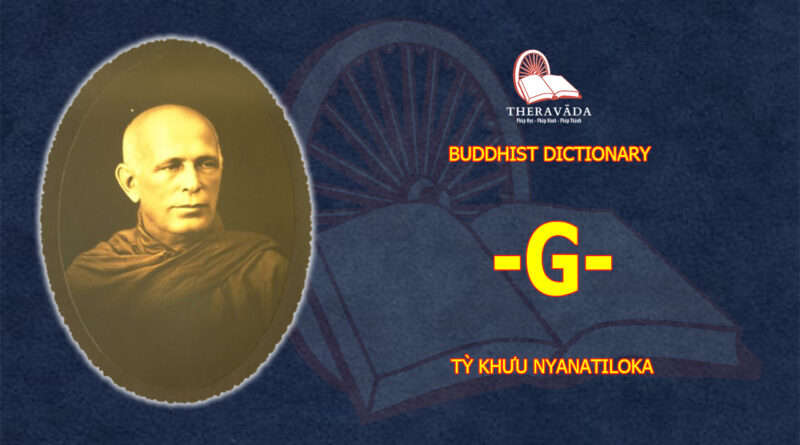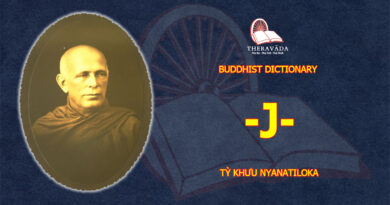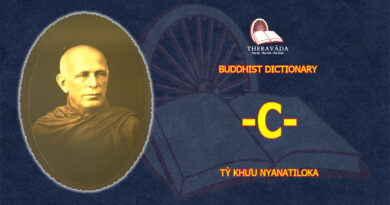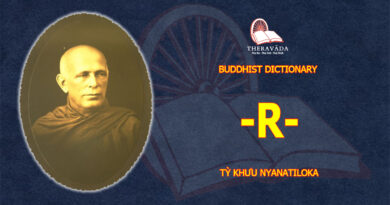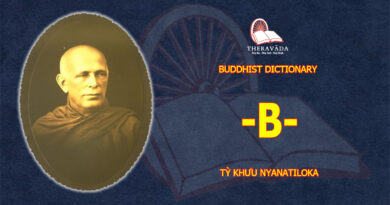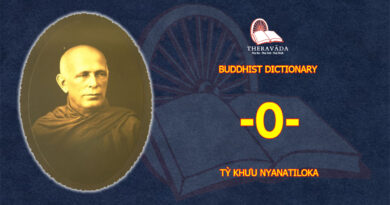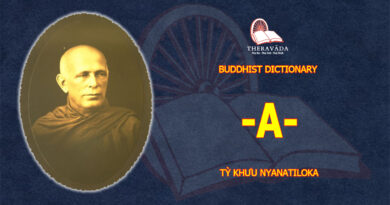BUDDHIST DICTIONARY
-G-
gantha: ‘ties’. “There are 4 ties: the bodily tie (kāyagantha) of covetousness (abhijjhā), of ill-will (byāpāda), of clinging to rule and ritual (sīlabbata-parāmāsa), of dogmatical fanaticism (idaṃsaccābhinivesa)” (D. 33). – “These things are ties, since they tie this mental and material body” (Vis.M. XXII, 54).
garuka kamma: weighty kamma; s. kamma.
gati (lit. ‘going’): ‘course of existence’, destiny, destination. “There are 5 courses of existence: hell, animal kingdom, ghost realm, human world, heavenly world” (D. 33; A. XI, 68). Of these, the first 3 count as woeful courses (duggati, s. apāya), the latter 2 as happy courses (sugati).
gems, the 3: ti-ratana (q.v.).
generation, the 4 modes of: yoni (q.v.).
germinating once more: eka–bījī, is the name of one of the 3 kinds of Sotāpanna (q.v.).
ghosts: cf. peta, yakkha; s. loka.
giving: dāna (q.v.).
gladness: somanassa (q.v.). – Indulging in g., s. manopavicāra.
gnosis: s. indriya (21).
gotrabhū: lit. ‘who has entered the lineage (of the Noble Ones)’, i.e. the Matured One.
I. ‘Maturity-Moment’ (gotrabhū-citta) is the last of the 4 impulsive moments (javana, q.v.; cf. viññāṇa-kicca) immediately preceding the entering into an absorption (jhāna, q.v.) or into one of the supermundane paths (s. ariya-puggala, A.). Cf. visuddhi VII.
II. The ‘Matured One’. “He who is endowed with those things, immediately upon which follows the entrance into the noble path (ariya-magga), this person is called a ‘Matured One’.” (Pug 10). In the Com. to this passage it is said: “He who through perceiving Nibbāna, leaves behind the whole multitude of worldlings (puthujjana, q.v.), the family of worldlings, the circle of worldlings, the designation of a worldling and enters into the multitude of the Noble Ones, the family of the Noble Ones, the circle of the Noble Ones, and obtains the designation of a Noble One, such a being is called a Matured One.” By this state of consciousness is meant the lightning-like transitional stage between the state of a worldling and that of a Sotāpanna; s. ariya-puggala. – Gotrabhū is mentioned in this sense, i.e. as 9th ariyapuggala (q.v.), in A. IX, 10; X, 16.
gotrabhū-ñāṇa: ‘Maturity-knowledge’; s. prec. and visuddhi (VII)
gradual instruction: ānupubbīkathā (q.v.).
grasping: cf. parāmāsa, upādāna.
great man, the 8 thoughts of a: mahāpurisa-vitakka (q.v.).
greed: lobha (q.v.).
greedy consciousness: s. Tab, I, III. (22-29).
greedy-natured: rāga–carita; s. carita.
grief: domanassa (q.v.) – Indulging in g. s. manopavicāra.
groups: of existence, s. khandha; corporeal groups, s. rūpa-kalāpa; corporeality-group, s. rūpa-kāya; mind-group, s. nāma-kāya.
growth, bodily: rūpassa upacaya: s. khandha I.
grudge: s. paṭigha.
gustatory organ: s. āyatana.

